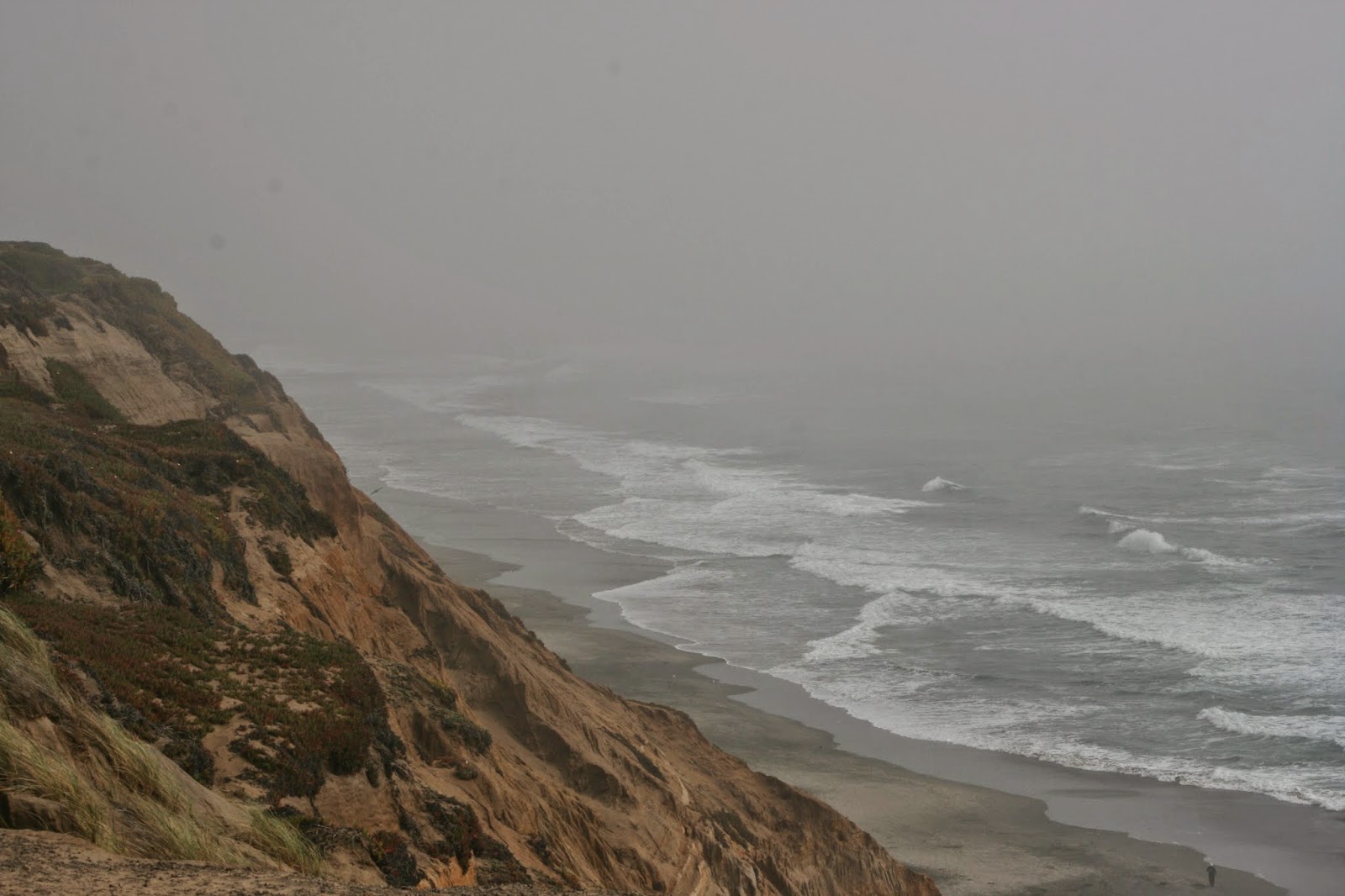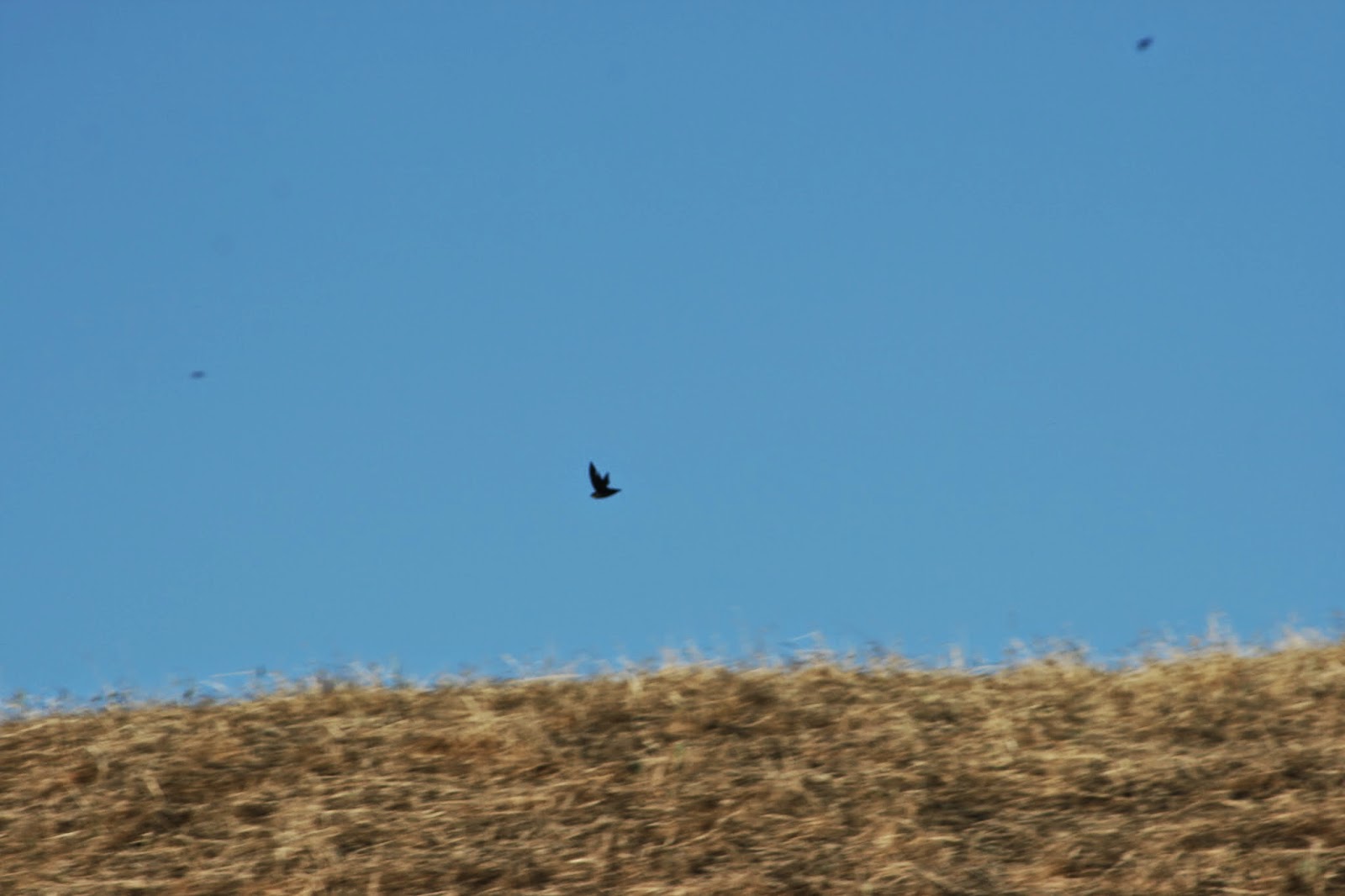On June 9th I went on another trip to the City, this time shorter than the first. We started in the early afternoon when my parents drove me to Fort Mason Park. There, I walked to the end of the municipal pier in hope of finding the Pacific Ocean's only Northern gannet resting on Alcatraz Island, as it has been doing so for the last few months. No luck though, as the fog began rolling in and the already distant island where I hoped to somehow find a white speck that wasn't one of the numerous western gulls became even more obscured. I did get a consolation prize-ish in the form of a life bird PIGEON GUILLEMOT swimming around on the walk back.
This bird is my first alcid (auks, puffins, etc.) on my life list. All alcids live on the ocean and this species is the one that usually ventures closest to shore.
Last year Santa Clara County had its first ever record of a pigeon guillemot - a juvenile bird lost at the Alviso salt ponds. I tried a few times but did not get to see it. Interesting how just the peninsula of the SF Bay can be such an effective barrier between where the guillemot and other species of seabirds are fairly common and where they are almost nonexistent.
Nesting Western gull
We then went west through the Presidio, making a brief stop before heading south to Golden Gate Park. There, I continued my search for the redstart which was still supposedly around but my attempt was fruitless. I then switched my focus in trying to find a male wood duck reported near the boathouse in Stow Lake, a short walk away. As I reached the area, all I saw were mallards and I nearly gave up but then the WOOD DUCK swam out from the willows, showing off his gorgeous coloration. Certainly not where I expected to see my first representative of this beautiful duck, with the species being far more common in the mountains of Santa Clara County than in suburban SF lakes.
Clear, unobstructed view of the Golden Gate Bridge
Juvenile white-crowned sparrow
Recently-fledged starling. More invasives have come to continue the takeover of the City.
What a magnificent bird. Aeks I mean Aix sponsa.
Gotta preen those feathers
As their name suggests, these ducks nest in trees. The documentary Planet Earth has a stunning and too-adorable-for-life sequence where the ducklings of the mandarin duck (same genus and same habits) jump out of the nest to the ground below as they start life.
Here is a link to the clip: https://www.youtube.com/watch?v=RVqS1UMr-eI
If only every bird could be as cooperative as this mallard. Oh wait didn't I say this in the previous post?
The final stop of the day was at Fort Funston right by the Pacific. Strong winds, heavy fog, and an ocean roaring from below me standing at the edge of a cliff made for an unforgettable experience. The most abundant bird in the area had a very fitting name: the common raven. I had never seen so many of these large corvids in one place before and they seemed to be enjoying the "pleasant beach breezes", performing aerial acrobatics and just appearing to be playing games with each other. The highlight of the trip was a single BANK SWALLOW, probably one of the members of the local breeding colony on the cliffs, which I was unfortunately unable to locate. No pictures were taken as the bird flew by rather quickly. After that brief encounter, I bid the ocean farewell and returned home.
Coast buckwheat
Beach strawberry patch
Oh the ocean. Despite the howling winds, this was a moment of serenity and mystique. Oh the possibilities of what lies beyond that metaphorical veil of fog. Or that literal veil of fog. Well I do know what lies behind the literal veil: thousands of pelagic birds.
Tree lupines in full bloom
Seaside daisies growing by the side of the sea.
On the 16th, I again decided to go and see the sunrise, getting up early to catch it at Shoreline before embarking on a pleasant half-day birding trip. The rising sun was beautiful just like last time, this time being partially covered with clouds. A small breeze also blew, making the slough's water not glassy still like last time but with gentle waves, creating a different but equally enchanted feeling. Birds seen at Charleston Slough were all the usual crew and the only skimmer I saw was one that noisily flew over without performing its amazing skimming so I did not get a chance to redeem myself for the horrid pictures taken on the 30th of May.
Oh the treasures of being alive - to experience nature at its best
Fog being illuminated by the rising sun.
My next stop was at salt pond A2E, where I enjoyed breakfast-ish on my favorite concrete slab. From there, I observed white pelicans working together to corral fish and terns gracefully flying around, with the occasional dive. As I got back on my bike to continue this little adventure, I spotted a pelican flying far out over the water that seemed different from the whites. Looking through binoculars, the bird turned out to be brown pelican, the first of its species seen by me in the county this year. A little bit further and I started to notice a tiny bit of movement to my right in the dried salt flats. The tiny scuttlers were snowy plovers, also new for the county this year (I saw them last year at the same place with chicks). I continued to bike through salt pond A3W, the Sunnyvale WPCP, and the Sunnyvale Baylands. Nothing was out of the ordinary but fledging Bullock's orioles at the Baylands and Vaux's swifts among the swallows at the WPCP were interesting to observe.
Forster's tern
Great blue heron
Snowy plover
Baby American avocet at A3W. What an adorable fluffball.
Marsh wren nest made by one talented weaver
The marsh beside Yahoo had a late / oversummering (more likely the latter) female bufflehead.
Hope she has friends around as it will be a few more months before the buffleheads return in large numbers for regular overwintering.
Large number of swallows at the WPCP
Vaux's swift
A family of Canada geese, with the young ones looking practically identical to the adults except for a slight size difference. Oh how quickly they grow up.
The most epic-looking cormorant ever.
Male Bullock's oriole
One of the fledglings struggling in the nets. Only a short summer left for it to master flight in preparation for the migration. Good luck little ones.
The last point of interest for the day was the 9 mile Alviso loop. There, I hoped to see some early phalaropes and a late redhead duck. As I arrived at the bayside location, the first thing I noticed was a huge flock of black birds (but not all blackbirds). The flock contained hundreds of red-wingeds in the saltmarsh and European starlings along with many Brewer's. I then scanned through the flock, eventually finding 3 adult tricolored males mixed in. These endangered birds were told apart from the red-winged peers with their contrasting white lines beneath the red wing patches and more blood red color in these patches than the red-winged's more orange red hues. There were likely more birds mixed in the flock, with younger males and females being harder to identify amidst the mixed flock.
Morning at the salt ponds
Err it's much better to see the enlarged version of this picture (click on it)
Tricolored male above and red-winged below.
Reflections of blackbirds (and brine flies on the surface)
As I continued biking the trail, I saw no phalaropes in any of the ponds but in Salt Pond A17 I did find the redhead, the first and only year bird of the day. Other interesting things seen on the trip included more giant flocks of birds, this time with cliff swallows as they descended over the saltmarshes to catch insects. From the saltmarsh also came the countless voices of many song sparrows and marsh wrens.
A mat of brine flies
A beautiful Caspian tern prowling the ponds
Don't know how this gull died. No signs of a struggle that would indicate predation. Did it really just get stuck in the algal mat? What a scary thought.
Tons of cliff swallows
Fascinating macro-algae that I believe to be Codium fragile, a somewhat invasive species.
SO MANY BIRDS
Hmm what could this strange, moving object be?
It was a bat ray!
I wonder what this beautiful fish was doing in such shallow water. Hopefully this isn't near-death behavior as last year in around the same area of Salt Pond A10 I saw a dead ray floating around.
The partially leucistic eared grebe (right-most bird) was still present in Salt Pond A12. The bird entered breeding plumage along with its friends.
With that, my loop around the salt ponds was over and I began to head home. The way back was not quite as interesting as the way there and the windy conditions were somewhat annoying. However, the trip as a whole was very satisfying, with perhaps the most individual birds (not species) seen by me in a day.
Anise swallowtail by A3W
Expert fisherman at Shoreline Lake
Yep I am pretty behind on my posts, especially as I have another huge section to cover with my recent lovely trip to Indiana. To those who read this blog, thanks a ton and until next time, enjoy life and love nature!
.jpg)
.jpg)


.JPG)

.JPG)
.JPG)
.JPG)
.JPG)

.JPG)



.JPG)
.JPG)
.JPG)
.JPG)

.JPG)
.JPG)
.JPG)
.JPG)
.JPG)
.JPG)
.JPG)


.JPG)
.JPG)
.JPG)


.JPG)
.JPG)
.JPG)
.JPG)
.JPG)



.JPG)
.JPG)

.JPG)
.JPG)
.JPG)
.JPG)
No comments:
Post a Comment